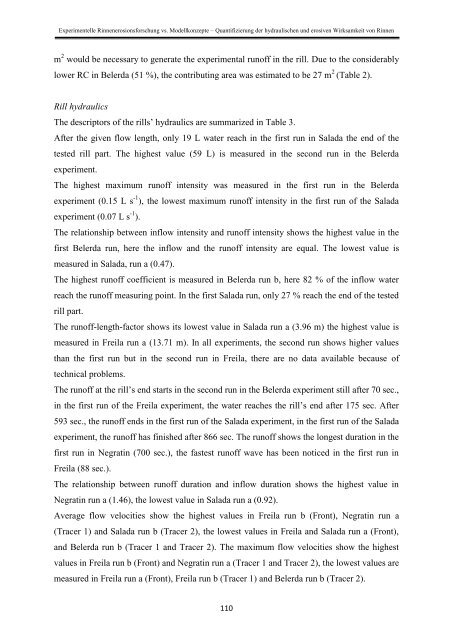Stefan Wirtz Vom Fachbereich VI (Geographie/Geowissenschaften ...
Stefan Wirtz Vom Fachbereich VI (Geographie/Geowissenschaften ...
Stefan Wirtz Vom Fachbereich VI (Geographie/Geowissenschaften ...
You also want an ePaper? Increase the reach of your titles
YUMPU automatically turns print PDFs into web optimized ePapers that Google loves.
Experimentelle Rinnenerosionsforschung vs. Modellkonzepte – Quantifizierung der hydraulischen und erosiven Wirksamkeit von Rinnen<br />
m 2 would be necessary to generate the experimental runoff in the rill. Due to the considerably<br />
lower RC in Belerda (51 %), the contributing area was estimated to be 27 m 2 (Table 2).<br />
Rill hydraulics<br />
The descriptors of the rills’ hydraulics are summarized in Table 3.<br />
After the given flow length, only 19 L water reach in the first run in Salada the end of the<br />
tested rill part. The highest value (59 L) is measured in the second run in the Belerda<br />
experiment.<br />
The highest maximum runoff intensity was measured in the first run in the Belerda<br />
experiment (0.15 L s -1 ), the lowest maximum runoff intensity in the first run of the Salada<br />
experiment (0.07 L s -1 ).<br />
The relationship between inflow intensity and runoff intensity shows the highest value in the<br />
first Belerda run, here the inflow and the runoff intensity are equal. The lowest value is<br />
measured in Salada, run a (0.47).<br />
The highest runoff coefficient is measured in Belerda run b, here 82 % of the inflow water<br />
reach the runoff measuring point. In the first Salada run, only 27 % reach the end of the tested<br />
rill part.<br />
The runoff-length-factor shows its lowest value in Salada run a (3.96 m) the highest value is<br />
measured in Freila run a (13.71 m). In all experiments, the second run shows higher values<br />
than the first run but in the second run in Freila, there are no data available because of<br />
technical problems.<br />
The runoff at the rill’s end starts in the second run in the Belerda experiment still after 70 sec.,<br />
in the first run of the Freila experiment, the water reaches the rill’s end after 175 sec. After<br />
593 sec., the runoff ends in the first run of the Salada experiment, in the first run of the Salada<br />
experiment, the runoff has finished after 866 sec. The runoff shows the longest duration in the<br />
first run in Negratin (700 sec.), the fastest runoff wave has been noticed in the first run in<br />
Freila (88 sec.).<br />
The relationship between runoff duration and inflow duration shows the highest value in<br />
Negratin run a (1.46), the lowest value in Salada run a (0.92).<br />
Average flow velocities show the highest values in Freila run b (Front), Negratin run a<br />
(Tracer 1) and Salada run b (Tracer 2), the lowest values in Freila and Salada run a (Front),<br />
and Belerda run b (Tracer 1 and Tracer 2). The maximum flow velocities show the highest<br />
values in Freila run b (Front) and Negratin run a (Tracer 1 and Tracer 2), the lowest values are<br />
measured in Freila run a (Front), Freila run b (Tracer 1) and Belerda run b (Tracer 2).<br />
110
















